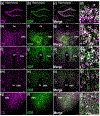Defining vitamin D receptor expression in the brain using a novel VDRCre mouse
- PMID: 33368246
- PMCID: PMC8053677
- DOI: 10.1002/cne.25100
Defining vitamin D receptor expression in the brain using a novel VDRCre mouse
Abstract
Vitamin D action has been linked to several diseases regulated by the brain including obesity, diabetes, autism, and Parkinson's. However, the location of the vitamin D receptor (VDR) in the brain is not clear due to conflicting reports. We found that two antibodies previously published as specific in peripheral tissues are not specific in the brain. We thus created a new knockin mouse with cre recombinase expression under the control of the endogenous VDR promoter (VDRCre ). We demonstrated that the cre activity in the VDRCre mouse brain (as reported by a cre-dependent tdTomato expression) is highly overlapping with endogenous VDR mRNAs. These VDR-expressing cells were enriched in multiple brain regions including the cortex, amygdala, caudate putamen, and hypothalamus among others. In the hypothalamus, VDR partially colocalized with vasopressin, oxytocin, estrogen receptor-α, and β-endorphin to various degrees. We further functionally validated our model by demonstrating that the endogenous VDR agonist 1,25-dihydroxyvitamin D activated all tested tdTomato+ neurons in the paraventricular hypothalamus but had no effect on neurons without tdTomato fluorescence. Thus, we have generated a new mouse tool that allows us to visualize VDR-expressing cells and to characterize their functions.
Keywords: RRID:AB_141637; RRID:AB_2157629; RRID:AB_2314007; RRID:AB_2715552; RRID:AB_2832252; RRID:AB_310305; RRID:AB_628040; RRID:AB_632069; brain; immunohistochemistry; mutant mouse strain; vitamin D receptor.
© 2020 Wiley Periodicals LLC.
Figures






Similar articles
-
Inhibitory neuron-specific Cre-dependent red fluorescent labeling using VGAT BAC-based transgenic mouse lines with identified transgene integration sites.J Comp Neurol. 2018 Feb 15;526(3):373-396. doi: 10.1002/cne.24343. Epub 2017 Nov 11. J Comp Neurol. 2018. PMID: 29063602
-
A novel mouse model of glucagon-like peptide-1 receptor expression: A look at the brain.J Comp Neurol. 2020 Oct;528(14):2445-2470. doi: 10.1002/cne.24905. Epub 2020 Mar 29. J Comp Neurol. 2020. PMID: 32170734 Free PMC article.
-
Developmental Vitamin D Deficiency and the Vitamin D Receptor Control Hematopoiesis.J Immunol. 2024 Nov 15;213(10):1479-1487. doi: 10.4049/jimmunol.2400292. J Immunol. 2024. PMID: 39320233
-
Mechanisms involved in bone resorption regulated by vitamin D.J Steroid Biochem Mol Biol. 2018 Mar;177:70-76. doi: 10.1016/j.jsbmb.2017.11.005. Epub 2017 Nov 14. J Steroid Biochem Mol Biol. 2018. PMID: 29146302 Review.
-
In vivo function of VDR in gene expression-VDR knock-out mice.J Steroid Biochem Mol Biol. 1999 Apr-Jun;69(1-6):247-51. doi: 10.1016/s0960-0760(99)00042-4. J Steroid Biochem Mol Biol. 1999. PMID: 10418998 Review.
Cited by
-
Characterization of Vitamin D Status in Older Persons with Cognitive Impairment.Nutrients. 2022 Mar 8;14(6):1142. doi: 10.3390/nu14061142. Nutrients. 2022. PMID: 35334800 Free PMC article.
-
Vitamin D and the Central Nervous System: Causative and Preventative Mechanisms in Brain Disorders.Nutrients. 2022 Oct 17;14(20):4353. doi: 10.3390/nu14204353. Nutrients. 2022. PMID: 36297037 Free PMC article. Review.
-
Novel insight into the role of the vitamin D receptor in the development and function of the immune system.J Steroid Biochem Mol Biol. 2022 May;219:106084. doi: 10.1016/j.jsbmb.2022.106084. Epub 2022 Feb 22. J Steroid Biochem Mol Biol. 2022. PMID: 35202799 Free PMC article.
-
The Synaptic and Circuit Functions of Vitamin D in Neurodevelopment Disorders.Neuropsychiatr Dis Treat. 2023 Jul 3;19:1515-1530. doi: 10.2147/NDT.S407731. eCollection 2023. Neuropsychiatr Dis Treat. 2023. PMID: 37424961 Free PMC article. Review.
-
A high-fat diet suppresses growth hormone synthesis and secretion by influencing the Vit D receptor and Pit1.Endocrine. 2025 Aug;89(2):508-520. doi: 10.1007/s12020-025-04270-3. Epub 2025 May 14. Endocrine. 2025. PMID: 40369297
References
Publication types
MeSH terms
Substances
Grants and funding
LinkOut - more resources
Full Text Sources
Other Literature Sources
Molecular Biology Databases

